The Evolution of Nail Art
The Evolution of Nail Art: A Journey from Simplicity to Sophistication
Nail art has transformed from a basic cosmetic routine into a dynamic medium of personal and artistic expression. This evolution mirrors broader cultural shifts, technological advancements, and the ever-changing fashion landscape. Let’s delve into the history, innovations, and trends that have shaped nail art into what it is today.
Introduction: The Evolution of Nail Art
Nail art, once a symbol of status and sophistication, has evolved into a ubiquitous form of self-expression that transcends cultural and social boundaries. This transformation from simple colour applications to various designs and techniques showcases a change in aesthetic preferences and a deeper, more profound shift in how we perceive personal style and identity. Let’s delve into the journey of nail art, highlighting its historical roots, the explosion of creativity it has witnessed in recent times, and its significance as a fashion statement and a medium of self-expression.
 From Ancient Rituals to Modern-Day Masterpieces
From Ancient Rituals to Modern-Day Masterpieces
Nail art’s origins can be traced back to ancient civilisations, where it served as a marker of social status and beauty. In ancient Egypt, for example, royalty favoured deep red hues to signify their status. In contrast, in ancient China, gold and silver polishes were created using egg whites, gelatin, beeswax, and gum Arabic during the Zhou Dynasty. Fast forward to the 21st century, and nail art has become a canvas for intricate designs, 3D elements, tiny jewels, and an endless spectrum of colours. The transition from these traditional polishes to today’s diverse palette signifies technological advancements and a cultural shift towards viewing the nail as an essential part of one’s fashion ensemble.
The Technicolor Revolution
The last few decades have seen a veritable explosion in the variety of nail polish colours and finishes available, thanks partly to the rise of indie brands. These small, often woman-owned businesses have pushed the boundaries of creativity, offering unique shades, textures, and finishes that challenge the status quo of the nail polish industry. From holographic polishes that shimmer with a rainbow of colours to thermochromic varieties that change colour with temperature, indie brands have introduced innovation and personalisation previously unseen in the market.
 Nail Art as Self-Expression and Fashion Statement
Nail Art as Self-Expression and Fashion Statement
Nail art today is much more than just a beauty trend; it’s a form of self-expression and an integral part of fashion. Each colour choice, design, and technique tells a story, conveying the wearer’s personality, mood, or political stance. Celebrity nail artists like Jenny Bui, known for her extravagant nail designs for Cardi B, and editorial nail artist Madeline Poole have elevated nail art to a form of high fashion, regularly featured in magazine spreads and on red carpets.
Experts in the field, such as Doug Schoon, co-chair of the Professional Beauty Association’s Nail Manufacturer Council, emphasise the role of nail art in individual identity: “Nail art has become a way to communicate one’s style without saying a word. It’s not just about colour anymore; it’s about using nails as an accessory.” This sentiment is echoed in the diverse array of tutorials available online, from YouTube to Instagram, where DIY nail artists share their creations, inspiring others to explore their nail art journeys.
Visual and Digital Influence
The digital age has significantly influenced the evolution of nail art, with platforms like Instagram and Pinterest serving as repositories of creativity and inspiration. Here, hashtags like #NailArt and #ManicureMonday circulate thousands of images of hand-painted designs, intricate patterns, and avant-garde nail sculptures, showcasing the work of both amateurs and professionals. This visual culture has democratised nail art, making it accessible to anyone with an internet connection and a bottle of polish.
Historical Perspectives on Nail Art
Nail art’s journey from ancient rituals to modern fashion statements is a fascinating tale of beauty, status, and self-expression. Understanding its origins and evolution provides insight into how this personal adornment has become a global phenomenon, reflecting cultural values and technological advancements.
Early Origins in Ancient Civilisations
Egypt and China: Birthplaces of Nail Coloring

The practice of colouring nails dates back to ancient civilisations, with the Egyptians and Chinese leading the way. In Egypt, around 5000 BC, nail colour indicated social status. Cleopatra and Nefertiti famously adorned their nails with deep shades of red, made from henna, signalling their royal standing. The Chinese took a different approach around 3000 BCE, using a mixture of beeswax, egg whites, gelatin, and vegetable dyes to stain their nails, often favouring gold and silver to symbolise wealth and power.
Cultural Significance Across Eras
These early uses of nail colouring were not merely aesthetic but deeply rooted in societal and cultural contexts. They were symbols of power, wealth, and refinement. As civilisations evolved, so did the significance and accessibility of nail art, transforming from a privilege of the elite to a universal form of expression and beauty.
The Evolution of Nail Polish Materials and Formulations
From Ancient Recipes to Modern Polishes
The journey from beeswax and henna to today’s high-tech polishes is a testament to human ingenuity and the desire for beauty. By the 19th century, tinted oils and powders were used for shine and colour, paving the way for the first modern nail polish in the 1920s, inspired by automobile paint—this revolutionised nail art, introducing a range of colours and the iconic glossy finish.
Technological Advancements in Formulations
Today’s nail polishes are feats of chemical engineering, offering many colours and various textures and effects (e.g., matte, glitter, metallic). Innovations such as gel polish and long-wear formulas have expanded the possibilities for nail art enthusiasts.
 The Cultural Significance of Nail Art Across Different Eras
The Cultural Significance of Nail Art Across Different Eras
A Reflection of Societal Values and Trends
Nail art has always mirrored the cultural and fashion trends of its time. The roaring twenties brought a wave of bold, vibrant nail colours, reflecting the era’s spirit of liberation and flamboyance. The post-war 1950s saw a return to classic elegance, with soft pinks and reds dominating the scene. The 1960s and 1970s introduced a psychedelic explosion of colour, coinciding with the youth culture’s rebellion against traditional norms.
Nail Art as a Form of Personal and Political Expression
In recent years, nail art has transcended its aesthetic value, becoming a medium for personal and political expression. From feminist symbols to LGBTQ+ pride flags, individuals use nail art to make statements and advocate for causes, showcasing its power as a tool for communication and activism.
The Technological Revolution in Nail Art
The realm of nail art has witnessed a remarkable transformation, driven by both technological innovations and the digital revolution. From the introduction of long-lasting UV gel nails and versatile acrylics to the pivotal role of social media in shaping trends, the landscape of nail art is ever-evolving. This segment explores how technology and digital platforms have influenced nail art, turning it into a global phenomenon.
The Advent of UV Gel Nails and Acrylics
The introduction of UV gel nails in the late 20th century marked a significant milestone in nail art history. These gels offered a durable, glossy finish that could last weeks without chipping, revolutionising how manicures were perceived and maintained. Acrylics soon followed, providing a strong, sculptable foundation for nail extensions and art. These innovations expanded the canvas for nail artists, allowing for more elaborate and enduring designs.
Expert Insight: Nail technicians and beauty historians highlight the impact of these materials on the industry. They note how UV gel and acrylics have enhanced nail art’s longevity and durability and opened up new avenues for creativity and expression.
Social Media: A Catalyst for Nail Art Trends
Social media platforms like Instagram and Pinterest have become the epicentres of nail art culture, showcasing various styles from artists worldwide. Hashtags like #NailArt and #ManicureMonday allow users to share their creations, discover new trends, and gain inspiration. Influencers and celebrities flaunting intricate nail designs further fuel the popularity of nail art, making it a staple of fashion and beauty discourse.
Contemporary Examples: Profiles of renowned nail artists on Instagram, such as @NailSunny and @AliciaTnails, demonstrate the platform’s role in elevating nail art from a hobby to a professional art form. Their collaborations with brands and celebrities underscore nail art’s commercial and cultural significance in today’s digital age.
Digital Tools and Apps: Democratizing Nail Art
The digital revolution has also ushered in an era of accessibility and innovation in nail art. Apps and online tutorials have democratised the craft, enabling enthusiasts at all skill levels to experiment with designs and techniques at home. Digital tools offer virtual try-ons, tutorials, and design inspiration, making exploring and executing complex nail art designs easier.
Innovative Apps: Applications like NailSnaps and virtual reality platforms allow users to design, visualise, and even order custom nail wraps from the comfort of their homes. These technologies inspire creativity and offer practical solutions for personalising their nail art experience.
Visual Elements and Tutorials
Visual content plays a crucial role in the dissemination and popularity of nail art trends. High-quality images and step-by-step tutorials aid in breaking down complex designs into manageable steps, fostering a learning community passionate about nail art.
Tutorials and Visual Inspiration: YouTube channels and Instagram accounts dedicated to nail art tutorials have become invaluable resources for beginners and experts. They offer insights into the design process, from basic techniques to advanced 3D art, encouraging viewers to engage with nail art in new and exciting ways.
The Rise of Indie Brands in Nail Art
The nail art industry has witnessed a significant transformation with the emergence of indie brands. These small, often independently owned companies have revolutionised the market by introducing many unique colours, innovative textures, and ethical formulations. Their rise is a trend towards more personalised, creative, and conscientious beauty standards.
Diversifying the Palette
Indie brands have played a pivotal role in expanding the colour spectrum of nail polishes. Unlike mainstream brands, which often stick to a conventional palette, indie labels dare to explore unconventional hues, from the deepest blacks to the most fluorescent neons. This diversity allows for a more expressive and individualised approach to nail art, enabling enthusiasts to experiment with looks that truly represent their style.
Historical Context: The indie nail polish movement gained momentum in the early 2010s as social media platforms like Instagram and Pinterest became popular. These channels provided a perfect showcase for indie creations, capturing the attention of a global audience hungry for new and distinctive nail art designs.
Contemporary Examples: Brands like Cirque Colors, ILNP (I Love Nail Polish), and Holo Taco have become household names among nail art aficionados. Their success lies in offering something beyond the mainstream—holographic finishes, colour-shifting chromes, or eco-friendly glitter polishes.
Case Studies of Success
Cirque Colors: Founded in New York City, Cirque Colors epitomises the indie brand ethos with its handcrafted, non-toxic nail polishes. The brand is celebrated for its vibrant colours and unique finishes, which have set new trends in the nail art community.
ILNP: This brand has carved a niche with its boutique nail polishes, known for their long-lasting wear and mesmerising holographic effects. ILNP’s products demonstrate how indie brands can influence mainstream beauty standards, pushing the boundaries of what’s considered fashionable in nail art.
Ethical Considerations
One of the most commendable aspects of indie nail polish brands is their commitment to ethical practices. Many of these companies prioritise cruelty-free testing, vegan formulations, and non-toxic ingredients, responding to the growing consumer demand for safe beauty products for both people and the planet.
Expert Opinions: Beauty industry analysts have noted that the rise of indie brands reflects a broader shift towards ethical consumerism. Nail artists and bloggers frequently highlight the importance of supporting brands that align with these values, recognising that beauty should not come at the expense of animal welfare or environmental health.
Visual and Tutorial Content
Indie brands often leverage visual content to showcase their products, utilising vivid photography and video tutorials that highlight the unique qualities of their polishes. From step-by-step guides on achieving the perfect holographic manicure to tips for using thermal polishes, this content educates and inspires creativity.
 DIY vs Professional Nail Art: A Comparative Insight
DIY vs Professional Nail Art: A Comparative Insight
Nail art’s journey from elite salons into the comfort of one’s home reflects a broader democratisation of beauty practices. Today, the line between DIY and professional nail art blurs, thanks to the proliferation of tools and resources accessible to enthusiasts at all levels. This segment delves into the nuances of DIY versus professional nail art, exploring cost, quality, creativity, and personal achievement.
Accessibility of Nail Art Tools and Resources
Historical Context: Initially, intricate nail designs were the hallmark of professional salons, with access to specialised tools and products. However, the 21st century has seen a significant shift. The internet era, particularly the rise of platforms like YouTube and Instagram, has democratised learning, making nail art tutorials and resources available to anyone with an internet connection.
Contemporary Examples: Brands like MoYou London and Bundle Monster (now called Maniology) have revolutionised the market with affordable stamping kits, dotting tools, and striping tapes, enabling intricate designs at home. Once exclusive to professionals, these tools have unlocked new creative possibilities for DIY artists.
Comparison of Cost, Quality, and Creativity
Cost: DIY nail art offers a cost-effective alternative to salon visits. While initial investments in tools and polishes are required, the ability to reuse these resources makes DIY a budget-friendly option.
Quality: Professional nail artists bring years of training and experience, ensuring high-quality, durable designs. However, the gap in quality between professional and DIY efforts has narrowed significantly, with many hobbyists achieving salon-grade results through practice and high-quality products.
Creativity: DIY nail art fosters a culture of experimentation and personal expression unmatched by salon services. While professionals offer expertise in executing complex designs, the DIY approach empowers individuals to explore their creativity without the constraints of salon menus or time limits.
Stories of Mastery and Personal Achievement
Expert Opinions: Renowned nail artists like Chelsea King and Madeline Poole acknowledge the rise of talented DIY nail artists, crediting social media platforms for showcasing diverse talents and inspiring trends. They note that many professionals started their careers by experimenting with nail art at home, highlighting the fluid boundary between amateur and expert status in this field.
Visual Elements: Instagram and Pinterest are replete with stunning DIY nail art examples, from simple geometric patterns to elaborate landscapes and portraits. These platforms not only serve as portfolios for individuals’ creativity but also as inspiration for others.
Tutorials and Trend Analyses: DIY tutorials have become a staple of nail art culture, with artists sharing step-by-step guides that demystify complex designs. Trend analyses by both DIY enthusiasts and professionals offer insights into evolving styles, from the resurgence of 90s-inspired designs to the incorporation of modern, minimalist aesthetics.
Weaving a Comprehensive Narrative
This exploration of DIY versus pr## Tools of the Trade in Nail Art
Nail art has seen a fascinating evolution, from using natural pigments to adorn nails in ancient civilisations to today’s high-tech tools and accessories. This section delves into the essential tools that have shaped modern nail art, offering historical insights and contemporary trends. We explore the creative potential each tool unlocks, guided by expert opinions and illustrated with examples of iconic designs.
 Dotting Tools: Mastering Detail and Texture
Dotting Tools: Mastering Detail and Texture
Historical Insight: Dotting tools, while seemingly modern, have roots in traditional artistry, where improvised devices like pins and sticks were used to create small, detailed patterns on various surfaces.
Contemporary Use: Today, dotting tools are indispensable for creating intricate designs, from simple polka dots to complex mandalas. These tools come in various sizes, allowing for precision and variety in design.
Expert Opinion: Renowned nail artists emphasise the versatility of dotting tools, highlighting their use in minimalist and elaborate designs. Techniques such as dotting gradients and layered textures showcase the tool’s range.
Visual Examples: Iconic designs include floral patterns where dots form delicate petals and abstract art that plays with dot sizes and colours for a mesmerising effect.
 Striping Tape: Crafting Clean Lines and Geometric Precision
Striping Tape: Crafting Clean Lines and Geometric Precision
Historical Insight: Tape in art can be traced back to painters who used it for crisp edges. In nail art, striping tape transformed the ability to create straight lines and patterns.
Contemporary Use: Striping tape is now a staple for achieving geometric designs, flawless French manicures, and intricate patterns that require precise lines.
Expert Opinion: Nail artists love striping tape for its ability to create defined spaces for colour blocking and its role in negative space designs, which have surged in popularity.
Visual Examples: Noteworthy designs include metallic stripes against matte backgrounds and rainbow patterns that showcase the tape’s potential for clean colour separation.
 Stencils and Decals: Simplifying Complex Artwork
Stencils and Decals: Simplifying Complex Artwork
Historical Insight: Stencils have been used in art for centuries, allowing for the replication of designs. Adapting stencils and decals in nail art brought complex imagery within reach of professionals and DIY enthusiasts.
Contemporary Use: Stencils and decals offer a shortcut to elaborate designs, from lace patterns to portrait art, making sophisticated nail art accessible to all skill levels.
Expert Opinion: Professionals point out that while stencils and decals simplify the process, placement and colour choice are crucial for a polished finish.
Visual Examples: Standout examples include intricate lace decals applied over nude polish and superhero logos captured perfectly with stencils.
Innovative Tools: The Future of Nail Art
Exploration of New Technologies:
- Magnetic Polishes: Utilise magnets to create mesmerising patterns and 3D effects that change with light and perspective.
- 3D Printers for Custom Decals: Personalisation reaches new heights with 3D printers that can produce bespoke decals, from personalised messages to photographic images.
Techniques and Trends in Nail Art: From Marbling to Airbrushing
Nail art is not just a beauty trend; it’s a form of personal expression that has evolved alongside fashion, technology, and cultural shifts. This section delves into the rich tapestry of nail art techniques, the latest trends, and their influences, bringing insights from historical practices to contemporary innovations.
Nail Art Techniques Explored
- Marbling: A technique that creates fluid, abstract patterns reminiscent of marble. Historically, marbling techniques were seen in Turkish Ebru art, which later inspired nail artists to replicate the effect using nail polish in water. This method involves dropping nail polish into water, creating a pattern with a tool, and dipping the nail onto the surface to transfer the design.
- Stamping: Introduced in the early 2000s, stamping has revolutionised DIY nail art. It involves transferring designs from etched plates onto nails using a stamper. This method allows for intricate patterns, previously achievable only by seasoned artists, to be accessible to enthusiasts at home.
- Airbrushing: A salon-favorite, airbrushing offers a gradient effect that’s smoother and more nuanced than traditional blending techniques. Utilising an airbrush machine, artists spray a fine mist of paint over the nails, often using stencils to create sharp designs or ombre effects.
Emerging Trends and Their Origins
Recent years have seen a surge in innovative trends, often influenced by social media platforms like Instagram and TikTok. Trends such as the “jelly nails” mimic jelly sandals’ translucent, colourful appearance, a nostalgic nod to the ’90s fashion. Another noteworthy trend is the “negative space” design, where parts of the nail remain unpainted amidst bold patterns, emphasising the artistry of omission, a concept borrowed from minimalist art movements.
The Influence of Fashion Runways and Celebrity Culture
Fashion runways have always been a significant catalyst for nail art trends. Designers collaborate with nail artists to complement their collections with thematic nail art, influencing trends for the upcoming season. For instance, the re-emergence of matte finishes and textured nail art aligns with the tactile fabrics seen in high-fashion collections.
Celebrity culture plays a pivotal role in popularising nail art designs. Stars like Rihanna, Lady Gaga, and Cardi B, known for their unique styles, often showcase elaborate nail art, inspiring fans to experiment with similar designs. Interviews with renowned nail artists like Jenny Bui, known as the “Queen of Bling,” reveal insights into the creative process behind these iconic looks.
The Artistic and Cultural Impact of Nail Art
Nail art transcends fashion trends to become a powerful medium for storytelling, cultural representation, and social commentary. Its canvas may be small, but its vast scope offers insights into individual identities, societal norms, and political landscapes.
Nail Art as Cultural and Personal Storytelling
Historically, nail colour and designs have held significant cultural meanings. In ancient Egypt, nail colours distinguished social hierarchies, with deeper hues reserved for royalty. In contemporary times, nail art has evolved into a form of self-expression that reflects one’s personality, mood, and interests. For example, national flags or traditional motifs during cultural festivals or global sporting events showcase pride and connection to one’s heritage.
Expert Opinion: Fashion historians and cultural studies experts can provide insights into how nail art reflects societal values and changes. A deep dive into specific cultural motifs that have found their way into mainstream nail art could reveal fascinating stories of globalisation and cultural exchange.
Challenging Beauty Standards and Promoting Inclusivity
Nail art has become a frontier in the beauty industry for challenging conventional standards and championing inclusivity. By embracing various styles, from the avant-garde to the minimalist, nail art demonstrates that beauty is not monolithic. The rise of gender-neutral nail salons and designs that appeal to all genders further underscores nail art’s role in promoting a more inclusive view of beauty.
Contemporary Examples: Highlighting nail artists and brands that actively promote diversity and inclusivity, such as those offering shades suitable for all skin tones or designs that challenge gender norms, could illustrate this point vividly.
Political Statements and Social Commentary
Nail art has also emerged as a subtle yet potent tool for political expression and social commentary. From the feminist movement’s bold, unapologetic colours to symbols of LGBTQ+ pride, nails have become canvases for solidarity and resistance. During election cycles, for instance, voters have sported nail designs featuring candidate slogans or party colours, turning manicures into political endorsement.
Visual Elements: Photos of nail art used in protests or campaigns can visually communicate the power of this medium. Designs incorporating symbols of peace, equality, or other social causes can serve as compelling examples of nail art’s ability to convey complex messages.
 Global Perspectives on Nail Art: A Cultural Tapestry
Global Perspectives on Nail Art: A Cultural Tapestry
Nail art, a dynamic form of self-expression and beauty, varies globally, influenced by cultural traditions, fashion trends, and technological advancements. This diversity not only enriches the world of nail art but also fosters a vibrant exchange of ideas and techniques, pushing the boundaries of creativity and innovation.
Cultural Roots and Evolution
Historically, nail colour and design have held various meanings worldwide, from denoting social status in ancient Egypt to symbolising the warrior class in feudal Japan. During the Zhou Dynasty in China, royalty wore gold and silver nail polish made from egg whites, gelatin, beeswax, and gum Arabic. By contrast, in the 21st century, global trends lean more towards a universal appeal, yet regional preferences and cultural influences remain strong.
Contemporary Global Trends
In South Korea, the “glass nails” trend mimics the appearance of shattered glass using holographic foil, showcasing the country’s innovative approach to beauty. Meanwhile, in the United States, the trend of “nail art storytelling”, where each nail serves as a canvas for a part of a larger narrative, highlights the personalisation and creativity in American nail art culture.
Brazil’s “Películas de Unhas,” thin nail films featuring intricate designs, often floral or lace patterns, reflect the country’s love for detailed and feminine aesthetics. In contrast, Europe’s fascination with minimalism is evident in the popularity of nude nails with subtle art, such as geometric shapes or fine lines, emphasising elegance and simplicity.
Expert Opinions and Cultural Exchange
Nail artists from around the globe share how cultural exchange influences their work. Renowned Japanese nail artist Naomi Yasuda, known for her elaborate designs, credits traditional Japanese art and New York’s vibrant fashion scene for her unique style, blending intricate details with bold, contemporary aesthetics.
British nail technician Sophie Harris-Greenslade, known for her intricate artwork, draws inspiration from historical European art, demonstrating how cultural heritage can influence modern nail art. These artists, among others, contribute to a global dialogue that continually introduces new materials, techniques, and designs into the nail art scene.
Visual Elements and Iconic Designs
Visuals play a crucial role in showcasing the global diversity of nail art. Photos of iconic designs, such as India’s Mehndi-inspired nail art, using delicate patterns that mimic traditional henna, or Australia’s Aboriginal dot painting designs, highlight how indigenous art forms and cultural narratives can be celebrated through nail art.
The Impact of Global Cultural Exchange
The internet and social media platforms like Instagram and Pinterest have accelerated the exchange of nail art trends and innovations, making it easier for artists to share their work and for enthusiasts to access tutorials and inspiration from around the world. This global network promotes cultural appreciation and encourages the fusion of styles, techniques, and traditions, leading to unprecedented creativity in nail art.
Future of Nail Art: Innovations and Trends Shaping Tomorrow
The landscape of nail art has continuously evolved, driven by technological advancements and consumer preference shifts. As we look toward the future, several key trends and innovations promise to redefine what’s possible in nail artistry. Here’s a glimpse into what we can expect, supported by historical insights, expert predictions, and the latest tech developments.
Technological Advancements in Nail Art
Integrating technology into nail art is not entirely new; UV lamps and intricate airbrush tools have been game-changers. However, the horizon is expanding with digital technology playing a pivotal role. 3D printing technology, for instance, is beginning to make its mark, allowing for precise and complex nail decorations that were previously impossible or too time-consuming to craft by hand.
Augmented Reality (AR) is another frontier. Brands like OPI have experimented with AR apps that let users try on nail colours virtually. The next step could be AR-guided nail art, where users can see and test designs on their nails before committing to them, making nail art more personalised and accessible.
Personalised and Augmented Reality (AR) Nail Art Experiences
The demand for personalised beauty experiences is growing, with consumers seeking products and services tailored to their preferences. AR technology is being developed to offer bespoke nail art designs that reflect individual tastes and styles. Imagine downloading a nail art app, inputting your preferences or outfits for the day, and receiving custom nail art suggestions that you can test virtually.
This technology enhances the user experience and is a powerful tool for nail artists, offering them a vast library of designs that can be adjusted to client specifications. It combines creativity and precision, where the digital and physical realms meet to create stunning nail art.
Sustainability in Nail Art
As awareness of environmental issues grows, sustainability has become a key concern in the beauty industry, including nail art. The future points toward eco-friendly practices and materials—biodegradable glitters, non-toxic polishes, and reusable nail art accessories are becoming more prevalent. Brands are increasingly committing to cruelty-free methods and vegan formulations, aligning with a more ethical approach to beauty.
Interviews with leading nail artists reveal a growing enthusiasm for sustainable nail art. They emphasise the importance of using safe products for their clients and the planet. Innovations like water-based polishes and recyclable packaging make it easier for professionals and DIY enthusiasts to make eco-conscious choices without compromising quality or creativity.
Emerging Trends
Trend analysis indicates a move towards more minimalist designs, contrasting the complex and maximalist patterns that have dominated the scene. This shift reflects a broader trend in fashion and design towards simplicity and understatement, with clean lines, subtle accents, and muted colours gaining popularity.
However, the joy of nail art lies in its diversity and the ability for trends to coexist. While minimalism rises, there’s also a continuous interest in bold, statement-making designs—from intricate lace patterns to vibrant, eye-catching graphics. The key trend is personalisation, with individuals seeking nail art to represent their unique identity.
Expert Opinions
Experts predict that a blend of artistry, technology, and sustainability will characterise the future of nail art. Nail artists like Betina Goldstein and Mei Kawajiri, known for their innovative designs, emphasise the importance of continuous learning and adaptation to new techniques and materials. They foresee a future where nail art remains a dynamic self-expression, constantly evolving with cultural and technological shifts.
Visual Elements and Tutorials
Visual content remains at the heart of nail art’s appeal. Social media platforms are rich with tutorials that showcase the latest designs and educate viewers on the techniques behind them. These resources are invaluable for beginners and seasoned artists looking to expand their skills and explore new trends.
Conclusion
Nail art’s journey from a simple beauty routine to an intricate form of self-expression mirrors the broader evolution of fashion and personal aesthetics. This transformation has redefined the boundaries of what can be considered art and highlighted the importance of nails as a canvas for creativity and individuality.
The Evolution of Nail Art
Historically, nail colour was a marker of social status and sophistication. Ancient Egyptians used henna to dye their nails, signalling wealth and status. In China, during the Zhou Dynasty, royals wore gold and silver polish, a tradition that spoke to the exclusivity of nail decoration. Fast forward to the 21st century, and nail art has exploded into a kaleidoscope of designs, techniques, and colours accessible to all.
Technological advancements have played a pivotal role in this evolution. The development of UV gel polishes and quick-dry formulas has expanded the possibilities for nail art, allowing for more complex and lasting designs. Social media platforms, especially Instagram and YouTube, have democratised nail art, enabling enthusiasts to share their creations, follow tutorials, and draw inspiration from a global community of nail artists.
The Artistic and Cultural Impact
Contemporary nail art transcends mere aesthetics, serving as a medium for personal expression and cultural identity. Icons like Rihanna and Lady Gaga frequently use nail art as an extension of their unique styles and personas, showcasing nail designs’ versatility and expressive power. Moreover, nail art has become a form of wearable art that allows individuals to communicate their moods, interests, and affiliations through the choice of designs and colours.
Expert opinions underscore the cultural significance of nail art. Renowned nail artists such as Jenny Bui, known for her extravagant crystal designs for Cardi B, emphasise that nail art is a form of self-care and self-expression, a way for individuals to showcase their creativity without uttering a single word.
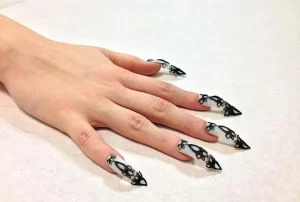
The Future of Nail Art
The future of nail art looks promising, with continuous innovation driving the industry forward. Technologies like 3D printing are beginning to make their way into nail art, offering the potential for even more personalised and intricate designs. The growing trend of eco-friendly and non-toxic nail polishes caters to the increasing demand for sustainable beauty products, pointing to a future where beauty and environmental consciousness go hand in hand.
The community of nail art enthusiasts continues to grow, fueled by online platforms and social media. This vibrant community shares tips and trends and supports indie brands and artists, fostering a culture of inclusivity and diversity.
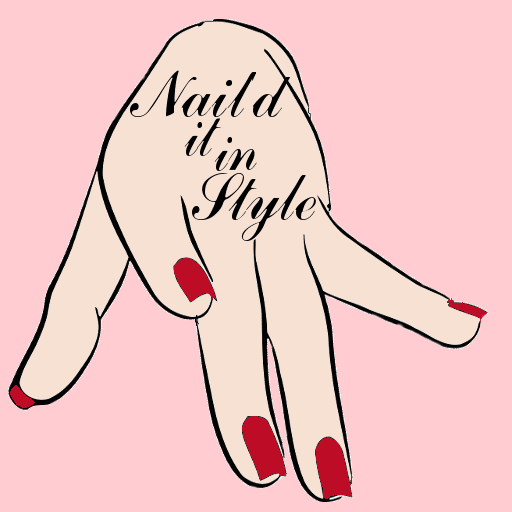
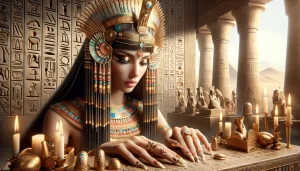 From Ancient Rituals to Modern-Day Masterpieces
From Ancient Rituals to Modern-Day Masterpieces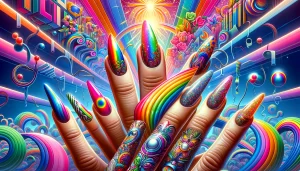 Nail Art as Self-Expression and Fashion Statement
Nail Art as Self-Expression and Fashion Statement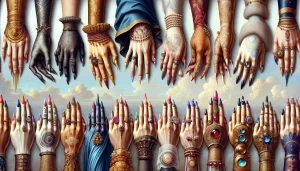 The Cultural Significance of Nail Art Across Different Eras
The Cultural Significance of Nail Art Across Different Eras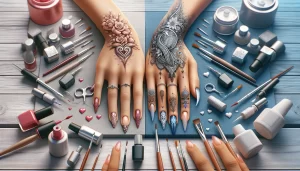 DIY vs Professional Nail Art: A Comparative Insight
DIY vs Professional Nail Art: A Comparative Insight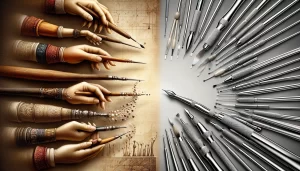 Dotting Tools: Mastering Detail and Texture
Dotting Tools: Mastering Detail and Texture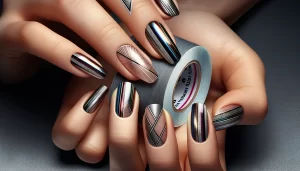 Striping Tape: Crafting Clean Lines and Geometric Precision
Striping Tape: Crafting Clean Lines and Geometric Precision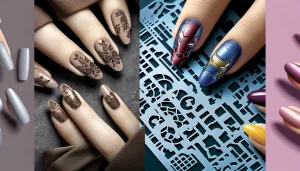 Stencils and Decals: Simplifying Complex Artwork
Stencils and Decals: Simplifying Complex Artwork Global Perspectives on Nail Art: A Cultural Tapestry
Global Perspectives on Nail Art: A Cultural Tapestry
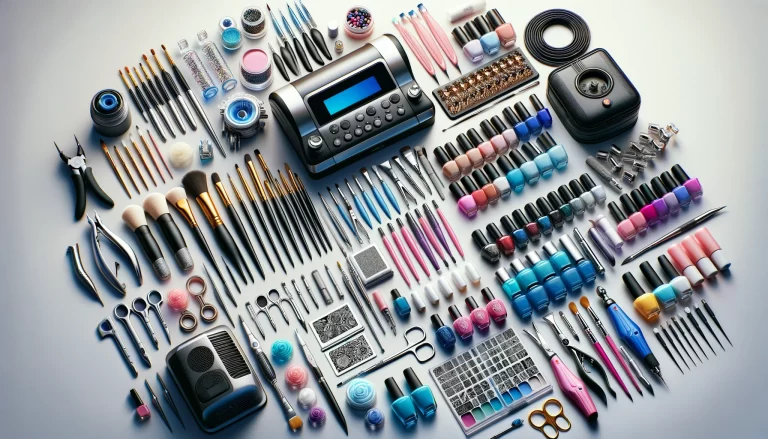
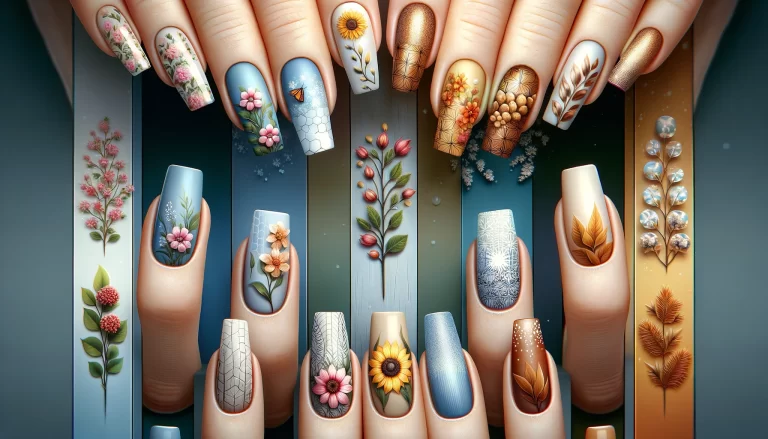
Leave a comment